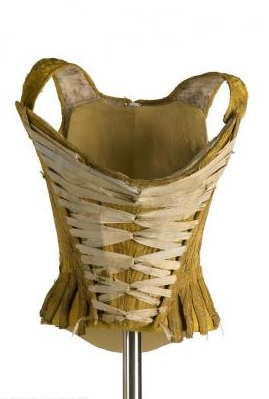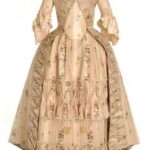
This garment was internationally known as “robe à la française”, although in Spain it was called a “bata”. The gown is characterised by flat pleats that emerge from the neck and run down the back to end in a train. These were only worn by women of a higher social class for various reasons: the cost of the materials and the amount of fabric used, as well as the need for help from other people (generally servants) to dress and undress. At the beginning of the 18th century, specifically during the regency of Louis XV, the canon of beauty evolved to models with large pleats. This type of model became known as “robe a la Watteau” although their corresponding pleats were also known as “Watteau pleats” as they were depicted perceptually by the French painter. As the century progressed, the pleats evolved: in 1730 they were very wide from one end of the shoulders to the other, while in the late 1780s they began to narrow. To wear a gown correctly, women had to wear two undergarments: on the upper part of the body, a cotilla (or corset) fitted with vallenas to fit the female figure, to which was added at the bottom a tontillo, or cupper, which was a frame of hoops giving it a characteristic shape.
Collection: Images
Project: 11. Science and culture as representation in Europe., 4. Family, daily life and social inequality in Europe.
Chronology: XVIII
Scope: Secondary Education, Baccalaureate, University
Link: https://museosenfemenino.es/museo_traje/cuerpos-modelables/bata
Resource type: Image
Source: Museo del Traje (Madrid)
Language: Spanish
Date: 1770
Owner: Álvaro Romero González (Modernalia)
Identifier: NS/NC
Copyright: Museo del Traje (Madrid)
Abstract: Illustrated piece of women's clothing with large volumes
Image
Tags






